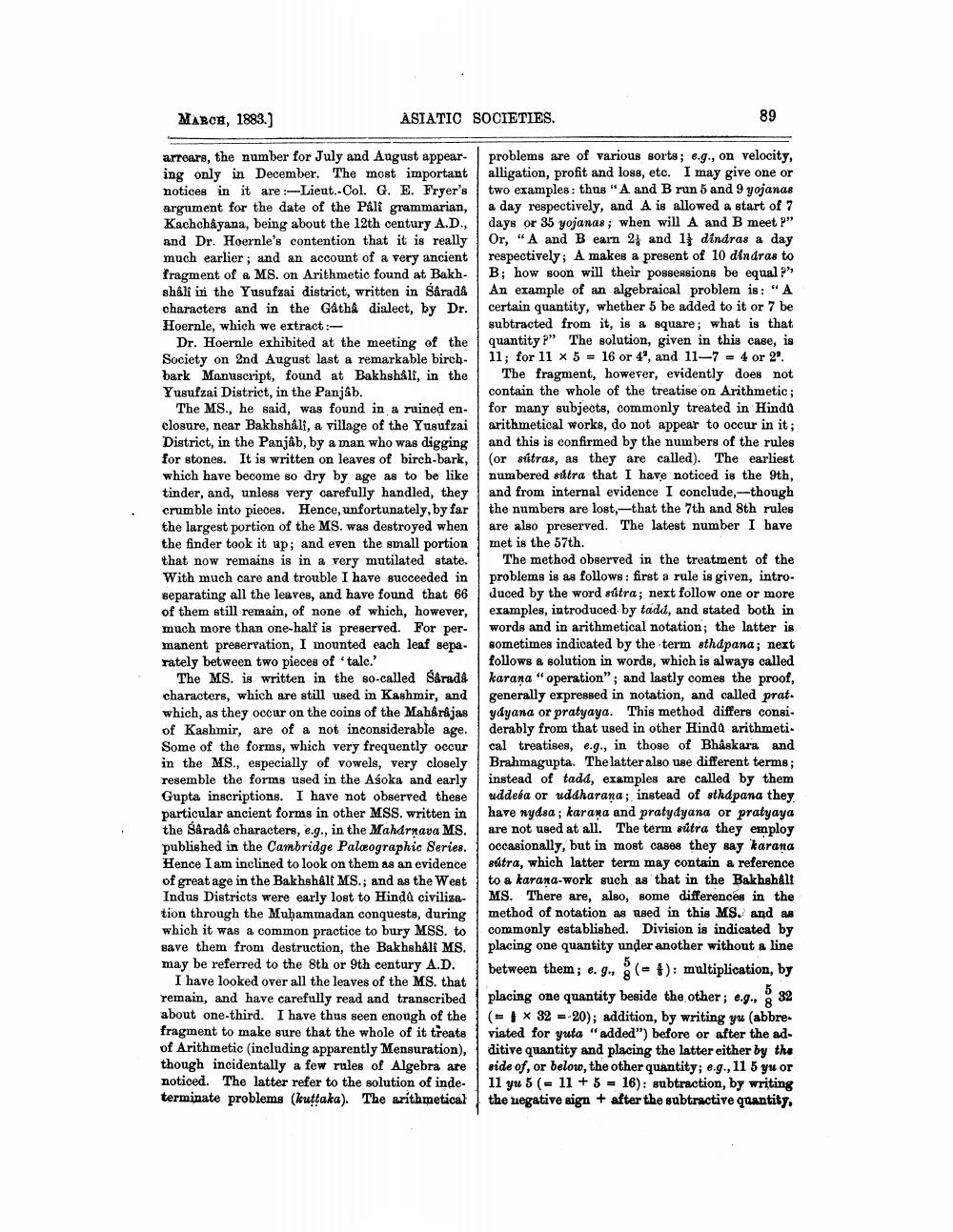________________
MARCH, 1883.)
ASIATIC SOCIETIES.
89
arrears, the number for July and August appear problems are of various sorts; e.g., on velocity, ing only in December. The most important alligation, profit and loss, etc. I may give one or notices in it are :-Lieut.-Col. G. E. Fryer's two examples: thus "A and B run 5 and 9 yojanas argument for the date of the Páli grammarian, a day respectively, and A is allowed a start of 7 Kachchảyana, being about the 12th century A.D., days or 35 yojanas; when will A and B meet P" and Dr. Hoernle's contention that it is really Or, "A and B earn 24 and 1} dindras a day much earlier; and an account of a very ancient respectively; A makes a present of 10 dindras to fragment of a MS. on Arithmetic found at Bakh. B; how soon will their possessions be equal shali in the Yusufrai district, written in Sarada An example of an algebraical problem is: “A characters and in the Gatha dialect, by Dr. certain quantity, whether 5 be added to it or 7 be Hoernle, which we extract:
subtracted from it, is a square; what is that Dr. Hoernle exhibited at the meeting of the quantity ?" The solution, given in this case, is Society on 2nd August last a remarkable birch 11; for 11 x 5 = 16 or 4', and 11-7 - 4 or 2". bark Manuscript, found at Bakhshali, in the The fragment, however, evidently does not Yusufzai District, in the Panjab.
contain the whole of the treatise on Arithmetic; The MS., he said, was found in a ruined en. for many subjects, commonly treated in Hindd closure, near Bakhshâli, a village of the Yusufzai arithmetical works, do not appear to occur in it; District, in the Panjab, by a man who was digging and this is confirmed by the numbers of the rules for stones. It is written on leaves of birch-bark, (or sútras, as they are called). The earliest which have become so dry by age as to be like numbered sutra that I have noticed is the 9th, tinder, and, unless very carefully handled, they and from internal evidence I conclude,-though crumble into pieces. Hence, unfortunately, by far the numbers are lost, -that the 7th and 8th rules the largest portion of the MS. was destroyed when are also preserved. The latest number I have the finder took it up, and even the small portion met is the 57th. that now remains is in a very mutilated state. The method observed in the treatment of the With much care and trouble I have succeeded in problems is as follows: first a rule is given, intro. separating all the leaves, and have found that 66 duced by the word siitra; next follow one or more of them still remain, of none of which, however, examples, introduced by tadi, and stated both in much more than one-half is preserved. For per- words and in arithmetical notation; the latter is manent preservation, I mounted each leaf sepa. sometimes indicated by the term sthapana; next rately between two pieces of tale.'
follows a solution in words, which is always called The MS. is written in the so-called Sarada karana "operation"; and lastly comes the proof, characters, which are still used in Kashmir, and generally expressed in notation, and called prat. which, as they occur on the coins of the Maharajas ydyana or pratyaya. This method differs consi. of Kashmir, are of a not inconsiderable age. derably from that used in other Hinda arithmeti. Some of the forms, which very frequently occur cal treatises, e.g., in those of Bhaskara and in the MS., especially of vowels, very closely Brahmagupta. The latter also use different terms; resemble the forms used in the Asoka and early instead of tada, examples are called by them Gupta inscriptions. I have not observed these uddeba or uddharana; instead of sthapana they particular ancient forms in other MSS. written in have nydsa; karana and pratydyana or pratyaya the Sarad characters, e.g., in the Mahdrnava MS. are not used at all. The term sútra they employ published in the Cambridge Palæographic Series. occasionally, but in most cases they say karana Hence I am inclined to look on them as an evidence stútra, which latter term may contain a reference of great age in the Bakhshalt MS.; and as the West to a karana-work such as that in the Bakhshall Indus Districts were early lost to Hindů civiliza- MS. There are, also, some differences in the tion through the Muhammadan conquests, during method of notation as used in this MS. and as which it was a common practice to bury MSS. to commonly established. Division is indicated by Bave them from destruction, the Bakhshali MS. | placing one quantity under another without a line may be referred to the 8th or 9th century A.D. between them; e. g., (-4): multiplication, by
I have looked over all the leaves of the MS. that remain, and have carefully read and transcribed placing one quantity beside the other; e.g. 32 about one-third. I have thus seen enough of the ( 1 x 32 -20); addition, by writing yu (abbrefragment to make sure that the whole of it treats viated for yuta "added") before or after the adof Arithmetic (including apparently Mensuration), ditive quantity and placing the latter either by the though incidentally a few rules of Algebra are side of, or below, the other quantity; e.g.,11 5 yu or noticed. The latter refer to the solution of inde- 11 yu 5 (- 11 + 5 = 16): subtraction, by writing terminate problems (kuttaka). The arithmetical the negative sign + after the subtractive quantity,




